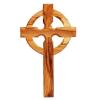Page 33 of the user guide is helpful with reference to non-unicode text, and what the settings should be.
■ RTF Features
ToolTip NT supports several rarely used RTF features. RTF refers to Rich Text Format, the markup syntax used for the creation of e-Sword modules. Just as HTML code presents and formats web content on web pages, RTF presents and formats content in e-Sword.
Include RTF Header
Access this setting by clicking Modules on the main menu. Note that Include RTF Header is either checked or unchecked. This feature should generally remain disabled. It’s unchecked by default.
e-Sword wraps module content with its own RTF header. This controls the standard font colors, font sizes, and font styles.
Enabling Include RTF Header prevents the e-Sword user from controlling the font size, link colors, and font styles. This is the reason this feature should generally not be used.
Include RTF Header should only be used if you have a document with Greek or Hebrew that uses a legacy font instead of Unicode. This preserves the legacy font usage if you distribute the legacy font with the module.
Use Old RTF Code
Access this setting by clicking Modules on the main menu. Note that when Use Old RTF Code is unchecked, the “New RTF Code” is used. Old RTF Code is disabled (unchecked) by default.
The Old RTF Code does not support images or hyperlinks. Also, for all module types except Bible, the “New RTF Code” presents content more reliably for technical reasons.
Old RTF Code should be used for Bible modules. Using the “New RTF Code” with Bible modules creates problems viewing the Bible module in e-Sword’s Parallel Mode.
View RTF / View Text
Access this command by clicking View on the main menu. Then choose View RTF. Select View Text to return to the normal text view.
View RTF reveals the raw RTF code. Advanced users will find value in being able to manually change the RTF code, such as removing unwanted background colors from text or tweaking text display.
The majority of users lack the technical skills to use this feature.
If you wish to experiment with this feature, do so with a backup of the file. Do not attempt to make changes to the RTF code of an original file since making a mistake could destroy the integrity of the text.



















